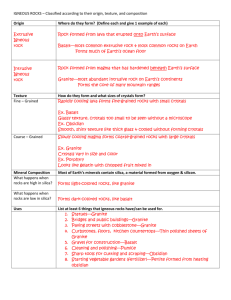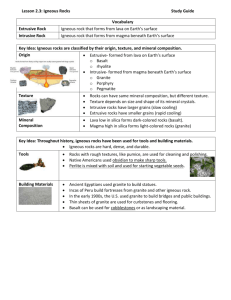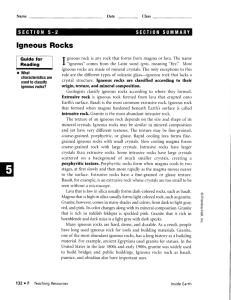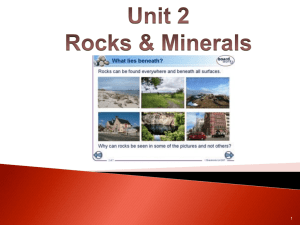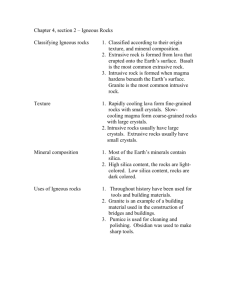How Earth's Rocks Were Formed
advertisement
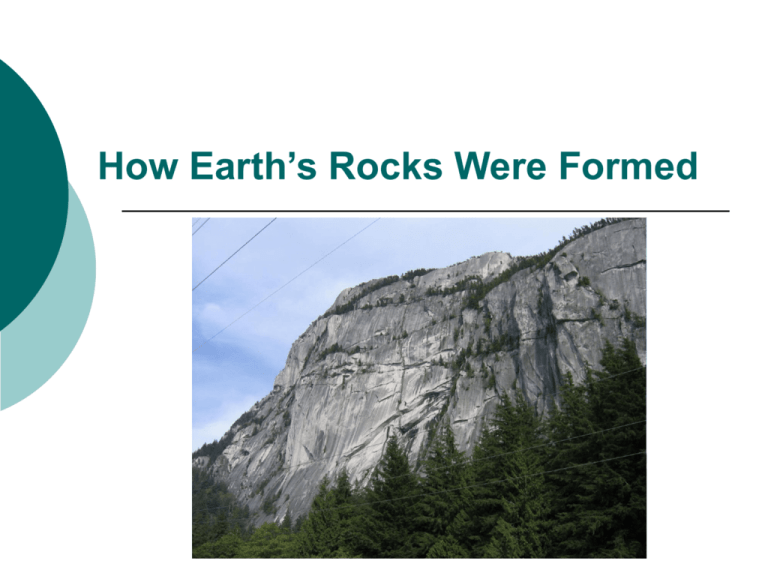
How Earth’s Rocks Were Formed Three Groups of Rocks A rock is a group of minerals bound together in some way Uniformitarianism explains the origin of rocks: all rocks of the crust form in one of three general ways. Igneous rocks are formed by the cooling and hardening of hot molten rock (magma) from inside Earth Sedimentary rocks are formed by the hardening and cementing of layers of sediments Metamorphic rocks are formed when rocks that already exist are changed by heat and pressure into new kinds of rocks Igneous Rocks Plutonic or intrusive rocks form underground from cooled magma eg. Granite Volcanic or extrusive rocks forms when lava cools on Earth’s surface Volcanic rocks lack distinct mineral grains Granite Basalt Magma Two general kinds of magma, both are silicates Temperatures range from 600°C to 1200°C One has a high % of silica (SiO2), and not much Ca, Fe, or Mg This high silica magma is thick and slow flowing, and forms light coloured minerals, called felsic rocks granite The second kind of magma has a lower % of silica, and a higher % of Ca, Fe, and Mg. This low silica magma is hotter,thinner, and more fluid, it forms rocks that are dark ferromagnesian minerals, called mafic basalt Texture of Igneous Rocks Texture depends on the size, shape, and arrangement of its mineral crystals Igneous rock range from glassy smooth to coarse grained Crystal size is the most important factor affecting texture, and it depends upon how fast the magma hardens The longer the magma stays liquid, the larger the crystals become A high % of dissolved gases helps crystals grow faster Magmas trapped in the crust grow slowly, such plutonic rocks have large mineral grains, and a coarse grained texture Granite Magmas that reach Earth’s surface as lava harden rapidly Volcanic rock that forms has tiny crystals Basalt is a good example Some rocks harden so rapidly that no crystals form at all and are glassy eg. obsidian Porphyritic Texture Some igneous rocks have two distinctly different textures Large crystals are surrounded by a fine-grained mass of rock Such a rock is called a porphyry Two stages of cooling can form a porphyry In the first stage the magma cools slowly at great depth, and large crystals can form, the rest of the magma remains liquid Then the magma moves up, and the rest of the magma cools into fine-grained rock around the first-stage crystals Families of Igneous Rocks: Granite Forms from felsic magmas Mainly orthoclase feldspar and quartz Likely minerals are plagioclase feldspar, mica, and some horneblende Usually light coloured Granite: coarse grained Rhyolite: fine grained Obsidian & pumice: glassy Granite Rhyolite Obsidian Families of Igneous Rocks: Gabbro Forms from mafic magmas Mainly dark plagioclase feldspar and augite Other likely minerals are olivine, hornblende, and biotite Generally dark in colour and dense Gabbro is coarse grained Basalt is fine grained Gabbro Basalt Families of Igneous Rocks: Diorite Composition and colour between those of granite and gabbro Diorite has less quartz than granite, and less plagioclase than gabbro Andesite is the finegrained member Diorite Andesite Some Igneous Rocks do not have a Family… Granodiorite is a coarse-grained rock, with a composition between granite and diorite Pyroxenite is nearly all pyroxene Dunite is almost all olivine Peridotite is a mixture of pyroxene and olivine. Granodiorite Pyroxenite Dunite Common Igneous Rocks Specific rocks can be identified by their minerals and texture Granite is made of quartz, orthoclase feldspar, and at least on other mineral, such as mica or hornblende, and is coarse-grained Quartz: little chips of cloudy or grayish glass Feldspar: smooth cleavage surfaces, is gray, pink or orange Mica: black biotite, is shiny little flakes Horneblende: tiny dull black chunks or sticks Obsidian Pumice Granite is the most common continental igneous rock. Felsite is the general name for any lightcoloured, fine-grained rock in the granite family. Rhyolite is an example Obsidian is a volcanic glass of the granite family. It is usually dark brown or black, hard and brittle, with conchoidal fracture. Pumice is formed from felsic lava that hardened while steam and other gases were still bubbling out of it. Basalt Gabbro Scoria The most common rock of the gabbro family is basalt Basalt ranges from dark green to black Gabbro has about the same composition as basalt, but is coarse grained Basalt glass is like obsidian but has a mafic composition Scoria is full of holes like pumice



